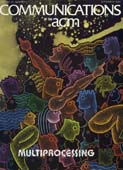September 1989 - Vol. 32 No. 9

Features
The relationship between business and higher education: a perspective on the 21st century
Apple's Chairman of the Board discusses the future of three core technologies—hypermedia, simulation and artificial intelligence—and the role each will play in education. The following speech was presented to an audience of teachers almost two years ago. Its message, however, is as timely and inspirational today as we prepare for a new era.
Using an architectural knowledge base to generate code for parallel computers
The authors present a reconfigurable compiler for distributed memory parallel computers that performs automatic program partitioning, mapping, and communication code generation under the guidance of directives supplied by the programmer.
Automatic determination of grain size for efficient parallel processing
The authors propose a method for automatic determination and scheduling of modules from a sequential program.
DEBL: a knowledge-based language for specifying and debugging distributed programs
DEBL provides a uniform, rigorous, and programming-language-independent environment for distributed program specification and debugging.
Using a global name space for parallel execution of UNIX tools
A parallel make utility that executes on multiple workstations and achieves a significant real-time speedup makes work with distributed computing easy to conduct.
The future of high performance computers in science and engineering
A vast array of new, highly parallel machines are opening up new opportunities for new applications and new ways of computing.
CASE productivity perceptions of software engineering professionals
Computer-aided software engineering (CASE) is moving into the problem-solving domain of the systems analyst. The authors undertook a study to investigate the various functional and behavioral aspects of CASE and determine the impact it has over manual methods of software engineering productivity.
A technique for two-dimensional pattern matching
By reducing an array matching problem to a string matching problem in a natural way, it is shown that efficient string matching algorithms can be applied to arrays, assuming that a linear preprocessing is made on the text.



